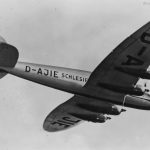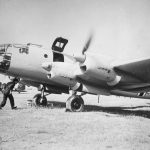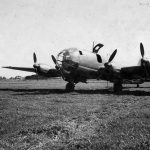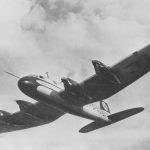He116 V-2 D-AJIE Schlesien in flight
He 116A
He 116 5
He116 on the ground
He116
He116 V-2 D-AJIE
He 116 was a four-engined low-wing monoplane that was intended to be used for mail flights over long distances, possibly as far as China and Japan. This required overcoming the Pamir Mountains and a corresponding altitude performance. A later area of use was the mapping and surveying of German territory.
Development began in 1936 at the request of Lufthansa, which at that time still considered a connection to China via Persia and Afghanistan possible. Therefore, the aircraft should not only have the longest possible range, but also an altitude performance of 7600 m with a high fuel load. Suitable engines for this purpose were not available in Germany, but Hirth Motoren GmbH planned an altitude engine with a power output of about 500 hp. The Günter brothers proposed modified wings of their Heinkel He 70 Blitz with four engines, which – as with the He 70 – were covered with plywood. The new fuselage made of duralumin was tightly riveted and had tight compartments so that it could float for a while in the event of a water landing. The designers were surely thinking of Lufthansa’s only long-haul mail route to South America. When the first prototype He 116 V1 was completed in 1937, the planned high-altitude engines were not yet ready and the prototype received eight-cylinder V-engines Hirth HM 508C with only 270 hp each. Despite this low power, the aircraft appeared suitable and Lufthansa began testing the V2 (D-AJIE, Lübeck ex Silesia) and V4 (D-ATIO, Hamburg) in 1938. The Hamburg crashed on the beach of Langeoog on 27 May 1938 in a reckless manoeuvre by the pilot. Among the three dead was the chief radio operator Karl Kirchhoff, one of Lufthansa’s most experienced Atlantic and long-haul pilots. The Lübeck was used at least four times on the mail route to South America between Frankfurt am Main and Las Palmas from 21 October to 1 January 1939. The Japanese had also shown interest in the aircraft and one of the pre-production aircraft had been used on the Sahara flight in 1938 with a Japanese crew. V5 (J-BAKD, Nogi) and V6 (J-EAKF, Tojo) were transferred to Japan in six days in April 1938. They covered the 15,251 km in 54 hours and 17 minutes flying time. They were subsequently deployed in Manchukuo.
The third prototype V3 was converted into a long-range record machine. The conversion also extended to larger wings with an area of 75.6 m² and a wingspan of 25 metres, as well as significantly more fuel tanks in the fuselage. Since no altitude performance was needed for the record, HM-508H engines with only 240 hp each – but more favourable fuel consumption values – were installed. Since the low take-off power and the high fuel load made take-off considerably more difficult, the He 116 V3, renamed D-ARFD Rostock, was fitted with four jettisonable take-off rockets. During the first attempt, one of the rockets detached prematurely and severely damaged one wing. After repairs, the second record attempt was made on 30 June 1938, covering 10,000 km on a closed course between Karlshagen and Leba in the record time of 46 hours and 18 minutes (216 km/h).
From December 1938, construction of the military variant He 116 A with a fully glazed nose was underway. It seems to have been originally intended for camouflaged photo reconnaissance flights. The mock-up inspection of the “He 116 for special purposes” took place on 3. February 1939 – after which the construction of twelve machines was released. When, after the beginning of the war, the General Luftzeugmeister ordered some developments to be stopped, he gave the following order for the He 116: “12 aircraft ordered for the z.b.V. Staffeln will be completed and available as long-range courier aircraft” In April 1940, the first He 116A (W.Nr. 3052) made its maiden flight. Series production ended in December of that year with the serial number 3063. The serial aircraft were designated He 116A, not He 116B, as is often read. After brief operational testing at the Experimental Centre for High Altitude Flight and the Reconnaissance Squadron of the Commander-in-Chief of the Luftwaffe, most of the aircraft went to various air service commands and schools, where they were “flown out”. The civilian registration plates used initially soon replaced by Stammkennzeichen. In January 1944, only three He 116 were still in the Luftwaffe inventory, two of them at schools.
Source
Ernst Heinkel Flugzeugwerke 1933-1945, Heel Verlag





